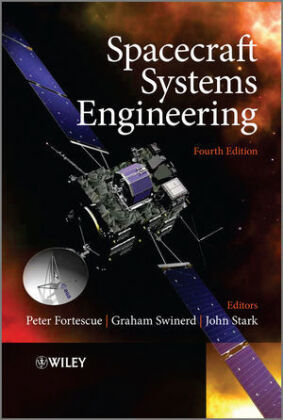Spacecraft Systems Engineering
| Verlag | Wiley & Sons |
| Auflage | 2011 |
| Seiten | 752 |
| Format | 24,6 cm |
| Gewicht | 1206 g |
| Artikeltyp | Englisches Buch |
| Reihe | Aerospace Series (PEP) |
| ISBN-10 | 047075012X |
| EAN | 9780470750124 |
| Bestell-Nr | 47075012EA |
This fourth edition of the bestselling Spacecraft Systems Engineering title provides the reader with comprehensive coverage of the design of spacecraft and the implementation of space missions, across a wide spectrum of space applications and space science. The text has been thoroughly revised and updated, with each chapter authored by a recognized expert in the field. Three chapters - Ground Segment, Product Assurance and Spacecraft System Engineering - have been rewritten, and the topic of Assembly, Integration and Verification has been introduced as a new chapter, filling a gap in previous editions.
This edition addresses 'front-end system-level issues' such as environment, mission analysis and system engineering, but also progresses to a detailed examination of subsystem elements which represents the core of spacecraft design. This includes mechanical, electrical and thermal aspects, as well as propulsion and control. This quantitative treatment is supplemented by an emphasis on the interactions between elements, which deeply influences the process of spacecraft design.
Adopted on courses worldwide, Spacecraft Systems Engineering is already widely respected by students, researchers and practising engineers in the space engineering sector. It provides a valuable resource for practitioners in a wide spectrum of disciplines, including system and subsystem engineers, spacecraft equipment designers, spacecraft operators, space scientists and those involved in related sectors such as space insurance.
In summary, this is an outstanding resource for aerospace engineering students, and all those involved in the technical aspects of design and engineering in the space sector.
Inhaltsverzeichnis:
Chapter 1: Introduction
John P. W. Stark, Graham Swinerd and Adrian R. L. Tatnall
Chapter 2: The Spacecraft Environment and its effect on Design
John P. W. Stark
Chapter 3: Dynamics of Spacecraft
Peter W. Fortescue and Graham Swinerd
Chapter 4: Celestial mechanics
John P. W. Stark, Graham Swinerd and Peter W. Fortescue
Chapter 5: Mission Analysis
John P. W. Stark and Graham Swinerd
Chapter 6: Propulsion Systems
J. Barrie Moss and John P. W. Stark
Chapter 7: Launch vehicles
J. Barrie Moss and Graham E. Dorrington
Chapter 8: Spacecraft Structures
John M. Houghton
Chapter 9: Attitude Control
Graham Swinerd and Peter W. Fortescue
Chapter 10: Electrical Power Systems
John P. W. Stark
Chapter 11: Thermal Control of Spacecraft
Chris J. Savage
Chapter 12: Telecommunications
Ray E. Sheriff and Adrian R. L. Tatnall
Chapter 13: Telemetry, Command, Data Handling and Processing
Nigel P. Fillery and David Stanton
Chapter 14: Ground Segment
Franck Chatel
Chapter 15: Spacecraft Mechanisms
Guglielmo S. Aglietti
Chapter 16: Spacecraft Electromagnetic Compatibility Engineering
Ken M. Redford
Chapter 17: Assembly, Integration and Verification
Terry Ransome
Chapter 18: Small Satellite Engineeing and Applications
Martin N. Sweeting and Craig I. Underwood
Chapter 19: Product Assurance
Geoffrey Hall
Chapter 20: Spacecraft Systems Engineering
Adrian R. L. Tatnall, John B. Farrow, Massimo Bandecchi and C. Richard Francis
Rezension:
"Summing Up: Recommended. Upper-division undergraduates through professionals/practitioners." ( Choice , 1 August 2012)
"I highly recommend the fantastic and landmark book Spacecraft Systems Engineering, Fourth Edition edited by Peter Fortescue, Graham Swinerd, and John Stark, to any graduate and undergraduate students, engineering and science faculty members, professional engineers, space scientists, business leaders, and government policy makers who are serious about the design, manufacturing, and implementation of complete spacecraft systems. This book provides not only the basics of fully integrated spacecraft systems, but the advanced knowledge required to implement a complete spectrum of space mission applications as well." (Blog Business World, 19 February 2012)

